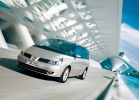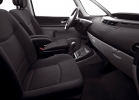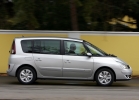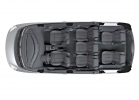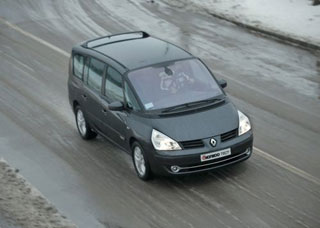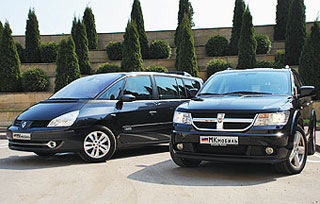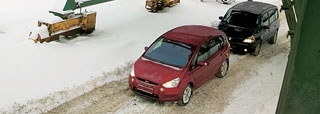Test drive by Renault Espace since 2006 Minivan
Opponent of the limousines
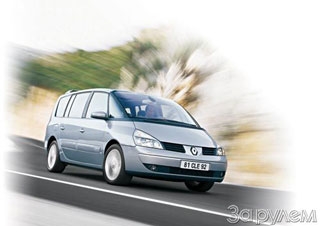 The fourth-generation Reno-Esps is like cars from fantastic novels
The fourth-generation Reno-Esps is like cars from fantastic novels The speed is not more than 130 km/h, the employee warned, handing the keys to the new Renault Espas.
The jokers ... slipped some kind of diesel aquarium, in which there are more glasses than in my apartment, and still mock. I'm not going to rush. Alien country, movement is worse than Brownian; The tightness is such that it seems that the mirrors stick out on the neighboring stripes, and crazy scooters fly by like bullets ... You feel like a beetle in an anthill.
Having twisted in the multi -storey interchanges of the Roman airport Leonardo da Vinci, I get out on the right road. The Carminat navigation system warned that the next turn would be only after 27 km, and took a timeout - you can relax and roll slowly, slowly mastering in the car.
A curious feeling - it seems to me that I have been familiar with her for a long time! I’m not talking about appearance - all the espasses are absolutely recognizable and carry the similarities, like members of the same family. The fourth-generation mini-wen received a modern cut and widely arranged wheels, increased to 16-18 inches. You find familiar features inside.
Typically, dials in front of the eyes, many switches and buttons around the driver push the driver to the role of the operator with smart equipment - he dutifully monitors throwing shooters, clicks switches, in a word - it works. Here, as in the previous, third Espas, you feel, as in a cozy, only more modern, apartment. Convenient soft chairs, covered with wicker fabric or alcantara, the front panel free from the instruments, a wonderful overview from the veranda - sit and enjoy life without straining the trifles. There are, of course, technocratic bells and whistles, but they are pushed into the background and are very unobtrusive.
 For example, the main remote control of the climate control was attached to the driver's door, a little smaller, for individual adjustment - with passengers. You get used to it quickly, finding your logic - after all, it is on the door that the buttons of electric windows are usually located, which are also responsible for the weather in the cabin. However, it will be necessary to correct the operation of automation: it receives information from the sensors of the intensity of sunlight, temperature, humidity and air pollution. The electric heaters built into the air heaters with a total capacity of 2 kW will help to quickly warm up the salon, and an autonomous heater per 5 kW is provided for the northern countries.
For example, the main remote control of the climate control was attached to the driver's door, a little smaller, for individual adjustment - with passengers. You get used to it quickly, finding your logic - after all, it is on the door that the buttons of electric windows are usually located, which are also responsible for the weather in the cabin. However, it will be necessary to correct the operation of automation: it receives information from the sensors of the intensity of sunlight, temperature, humidity and air pollution. The electric heaters built into the air heaters with a total capacity of 2 kW will help to quickly warm up the salon, and an autonomous heater per 5 kW is provided for the northern countries. The information display was hidden in a narrow niche at the base of the windshield, as if to say: you can not look at me, but I am ready to provide any information. By the way, what kind of 142 is it displayed on it? Lord, yes this is my speed! And I thought, I’m going ninety kilometers, no more ...
That's what I feel the discord in sensations: the eyes suggest that the speed is considerable, and the hearing, hands, the whole body argue - it cannot be, because there is no tension, trembling of steel muscles, protesting groans of the broken space. With such a magnificent noise and vibration insulation, you face infrequently.
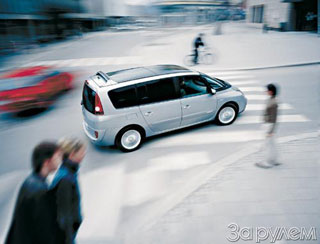 To be precise, the level of noise exposure to Espas IV is 50% lower than the permissible limit and is 71 dB (a). But under the hood is by no means a sewing machine-the most powerful turbodiesel that has ever been installed on mini-wen: six cylinders, three liters, 180 forces. However, the range of power units is very wide, in it six motors can be chosen more modest. For example, one of two economical turbodiesels: 2.2 liters (150 hp) - this predicts the maximum popularity of up to 50% of sales, or 1.9 liters (120 hp). There are a pair of two -liter gasoline in atmospheric (140 hp) or turbocharged (165 hp) variants. A six -speed manual gearbox is intended for the motors, for powerful ones, an adaptive five -speed machine with manual control. At the very top there is a 3.5 -liter gasoline six, almost two and a half hundred. This is a power record for mini -wenes - this is exactly what I got in a couple of hours. Well, I’ll tell you, call it the language simply does not turn it-in the sprint it will not give in to most high-speed sedans, accelerating to 100 km/h for 8.1 s and reaching a maximum speed of 225 km/h!
To be precise, the level of noise exposure to Espas IV is 50% lower than the permissible limit and is 71 dB (a). But under the hood is by no means a sewing machine-the most powerful turbodiesel that has ever been installed on mini-wen: six cylinders, three liters, 180 forces. However, the range of power units is very wide, in it six motors can be chosen more modest. For example, one of two economical turbodiesels: 2.2 liters (150 hp) - this predicts the maximum popularity of up to 50% of sales, or 1.9 liters (120 hp). There are a pair of two -liter gasoline in atmospheric (140 hp) or turbocharged (165 hp) variants. A six -speed manual gearbox is intended for the motors, for powerful ones, an adaptive five -speed machine with manual control. At the very top there is a 3.5 -liter gasoline six, almost two and a half hundred. This is a power record for mini -wenes - this is exactly what I got in a couple of hours. Well, I’ll tell you, call it the language simply does not turn it-in the sprint it will not give in to most high-speed sedans, accelerating to 100 km/h for 8.1 s and reaching a maximum speed of 225 km/h! The appearance of such powerful power units is not accidental. The fact is that the creators of Espas aimed him on the most prestigious market segment-a representative E-class, in which the new mini-van will be distinguished only by the shape of the body. As for equipment, comfort, safety - all according to the highest standards. For example, the owner will be identified automatically - on a card, hidden somewhere in a wallet. It is enough to go to the door and take up the handle - the locks are instantly unlocked. On the card, individual adjustments of the seats, mirrors, audio and climatic systems will be restored. It remains only to press the engine start button. After that, the electronics will check the pressure in the wheels, highlighting the values \u200b\u200bon the central display, and at the time of touching will automatically release the parking brake. Everything, as on the representative Renault Vel Satis.
 In the rain, wipers will come to life by themselves, in the evening bixenon headlights with automatic adjustment will turn on. A curious feature - by switching to the near light, the special curtain in the headlight knows.
In the rain, wipers will come to life by themselves, in the evening bixenon headlights with automatic adjustment will turn on. A curious feature - by switching to the near light, the special curtain in the headlight knows. Depending on the speed, the sound level of Hi-Fi will adjust the audio system Gran Auditorium. There is little one sound - order an image with a whole DVD studio: a player, two liquid crystal displays in the front headrests, two pairs of wireless headphones, a video camera or a digital camera, a remote control. Against this background, it is even embarrassing to talk about trivial things such as cruise control or parking sensors.
At one time, Espas III struck me with a comfortable salon with the richest possibilities of transformation - the fourth -generation model went even further. Of course, there are curtains, armrests, leaning tables, boxes-nishi-kartes with a total volume of 100 liters (!) And other pleasures laid down by the mini-van. But not a single wagon has such advanced security systems - it seems that five out of five possible stars (according to the EURONCAP method) on Renault want to make the norm.
However, the stars are stars, not purely earthly concerns. The light dent on the front wing is slightly heated - and the thermoplast will restore its original shape. The consequences of collisions at speeds up to 15 km/h - radiator, wings and spaces will remain minimized. The intervals between oil replacements are increased to 30 thousand km or two years (20 thousand km for six -cylinder engines), the air filter will have to be changed only after 60 thousand km, candles and gas distribution belt will last 120 thousand km, and the exhaust system of stainless steel will last It seems to survive more than one change of owner. As a result, the cost of service in comparison with the previous model was doubled.
 Remember the pictures from the science fiction books that were read out in childhood? There were still such streamlined glazed drops - cars of the future. It looks like it has come ...
Remember the pictures from the science fiction books that were read out in childhood? There were still such streamlined glazed drops - cars of the future. It looks like it has come ... The semblance of anti -wing on the roof is not only an element of decor - these are the arcs moving along the longitudinal skids, on which, say, skis can be transported.
You can confidently identify the Espas Grand Prix only when an ordinary Espas is standing nearby - an insignificant (65 mm) increase in the base conceals an increase in 200 mm of total length, leaving the silhouette as proportional. Meanwhile, the minimum volume of the trunk of Grand Espas increased one and a half times (456 l), and the maximum - exceeded three cubic meters (3050 l).
The chairs of the second and third row are exactly the same - they can be shuffled in any order.
The design and layout of the Reno-Espassa IV repeats the mini-van of the previous generation: a supporting body, front-wheel drive with a transverse location of the power unit, in front-the racks of McEferson, in the back-an uncertain beam.
 In terms of passive security, the Reno -Espassa IV overtook all classmates and came close to representative cars: three -point seat belts in all seats, and in the front - two pyrotechnic tensioners (for each branch); eight airbags, including adaptive frontal and full -size side curtains; Inflatable cavities in the rear seats pillows that prevent passenger slipping. In addition, the use of steel with an ultra -high fluidity limit increased the energy -absorbing ability of the body by 2.5 times.
In terms of passive security, the Reno -Espassa IV overtook all classmates and came close to representative cars: three -point seat belts in all seats, and in the front - two pyrotechnic tensioners (for each branch); eight airbags, including adaptive frontal and full -size side curtains; Inflatable cavities in the rear seats pillows that prevent passenger slipping. In addition, the use of steel with an ultra -high fluidity limit increased the energy -absorbing ability of the body by 2.5 times. Instead of the usual dashboard - an information display at the base of the windshield.
Such a powerful motor on the mini -wen has not yet been installed - 3.5 l, V6, 245 liters. With. And 330 N.M!
Half of the glass roof is occupied by a giant transparent hatch with an area of \u200b\u200b2.16 m2 - they say the largest in a modern automotive industry. The total glazing area reaches 7.42 m2! If desired, you can take refuge with a curtain that looks like a completely ordinary ceiling.
The history of the model
In 1979, the Matra Automobile company began work on creating a single -volume car, using the American Ranch model as a prototype. Having evaluated the prospects of the idea, a little later the Renault company connected to the development, and soon the first P23 project was ready at the Renault-18 front-wheel drive chassis. In the summer of 1984, the release of the mini-wan Reno-Espas began at the mattra plant, which in seven years spread out of the circulation of 191694 pcs. Since 1988, the program even had an all-wheel drive modification. In 1991, the second generation Espas appeared. Having increased the popularity of its predecessor, over the next five years it was released already in the amount of 317225 pcs. At the very end of 1996, Espas III was shown - unlike predecessors with a longitudinal location of the engine, they moved to the transverse scheme. For incomplete six years, 357120 mini-wenes were sold, including (since 1997) and the elongated Grand of Espas (ZR, 1998, No. 6). In August of this year, Reno-Espas IV made their debut. Until 2009, it is planned to sell 450,000 cars, occupying about 20% of the mini-wen market in Europe. These ambitious plans are based on the highest in the segment of commitment to the model - two of each three buyers had already had Espas before.
Text / Yuri Nechetov
Photo / Yuri Nechetov and Renault

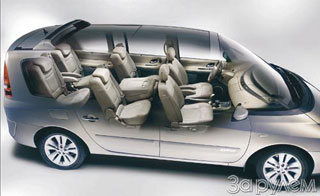
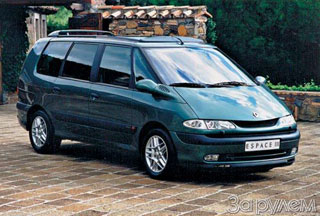



Source: The magazine "Driving"

